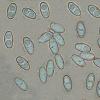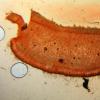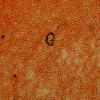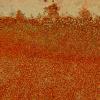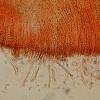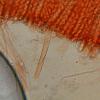
12-11-2025 09:25
 Viktorie Halasu
Viktorie Halasu
Hello, I need help with a pale terrestric Pseudom

11-11-2025 20:16
Bohan JiaHi, lastly I have found these tiny yellow decayin

09-11-2025 13:20
Hello.A tiny ascomycete, appearing as erupting gra

08-11-2025 00:29
 Francois Guay
Francois Guay
I found this species in Quebec, Canada, on herbace
Otidea from Mexico
Alan Rockefeller,
21-02-2013 01:39
 I found this Otidea in Mexico under oaks.
I found this Otidea in Mexico under oaks.http://mushroomobserver.org/images/960/280048.jpg
http://mushroomobserver.org/images/960/308999.jpg
Spores 2/3rds with 2 oil droplet and 1/3rd with one. Spore measurements:
10.2 [11 ; 11.4] 12.2 × 5.3 [5.7 ; 5.9] 6.3 µm
Q = 1.8 [1.9 ; 2] 2.1 ; N = 30 ; C = 95%
Me = 11.2 × 5.8 µm ; Qe = 1.9
Rarely (approx 1%) of the spores are up to 8 µm wide.
Asci with blunt tips. Paraphyses curly.
A video of spore release:
http://www.youtube.com/watch?v=HT_0UU7UgI0
More photos and micrographs:
http://mushroomobserver.org/115972
Any help with identification would be greatly appreciated.
Ibai Olariaga Ibarguren,
21-02-2013 02:57
Re : Otidea from Mexico
Hi Alan,
Thank you for this nice post! From what I can see in the photos, it looks very much like an undescribed species of Otidea close to O. formicarum, from which it differs clearly in the longer spores with higher length/width ratio, among other things. The apothecia with upper horizontal margin, dark brown colour, and especially, the spore size are very characteristic. I have seen only two herbarium specimens from Mexico, but never got to see good photos of living material. That is why your material is very interesting if I am in the right path.
Are the photos "pileipellis x 100" and "pileipellis x 400" taken in water?
Was not there any conifer tree in the collection site? The two collections I studied were made under Abies and Pinus.
If possible, I would be interested in studying the material to confirm the find. Many thanks in advance. ?
Cheers,
Ibai.
Alan Rockefeller,
21-02-2013 03:16

Re : Otidea from Mexico
The photos you asked about were mounted in KOH. There were mostly oaks near the collection site, but there are a few pines around so it is possible that it is with Pinus.
I can have the collection mailed to you, let me know where to send it.
Thanks for the help!
I can have the collection mailed to you, let me know where to send it.
Thanks for the help!
Nicolas VAN VOOREN,
21-02-2013 08:13

Re : Otidea from Mexico
Well, I'm troubled because I proposed, on Mushroom Observer, Otidea bufonia as name, due to purplish tinges shown on some specimens. The habitat under oak was also possible for this species. I agree that the spore size is a bit small for typical bufonia.
Ibai, I do not recognize the Otidea close to formicarum that we discuss.
Maybe a new taxon...
Ibai, I do not recognize the Otidea close to formicarum that we discuss.
Maybe a new taxon...
Ibai Olariaga Ibarguren,
21-02-2013 09:36
Re : Otidea from Mexico
Hi Alan and Nicolas,
I agree that it resembles O. bufonia macroscopically. In fact, I thought it was O. bufonia at the first glance too! Besides having larger fusoid spores, O. bufonia should have dark brown crystals on the surface of the outer excipulum that partly convert into reddish particles in Melzer. The ecology would be OK, but it appears to occur only in Europe, so far. The crystals on the outer excipulum in the O. formicarum group are yellowish brown to yellow and convert into heterogeneous amber drops in Melzer. Yes Nicolas, very likely new...
I would need to check the material to be sure, though. Alan, I will send my address privately. Thank you!
Cheers,
Ibai.
Ibai.

